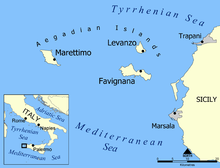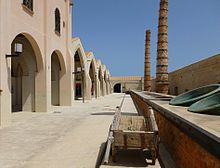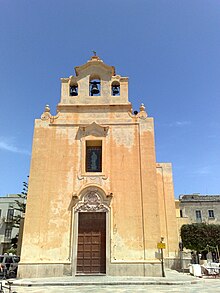Favignana
| Favignana | ||
|---|---|---|

|
|
|
| Country | Italy | |
| region | Sicily | |
| Free community consortium | Trapani (TP) | |
| Local name | Favignana | |
| Coordinates | 37 ° 56 ' N , 12 ° 20' E | |
| height | 6 m slm | |
| surface | 37 km² | |
| Residents | 4,313 (Dec 31, 2019) | |
| Population density | 117 inhabitants / km² | |
| Post Code | 91023 | |
| prefix | 0923 | |
| ISTAT number | 081009 | |
Favignana is one of the Egadi Islands in the Mediterranean off the west coast of Sicily . Politically, this island also forms the largest part of the municipality of Favignana in the Free Municipal Consortium Trapani in the region of Sicily in Italy with 4313 inhabitants (as of December 31, 2019).
Location and dates
The island of Favignana is the largest of the Egadi Islands with an area of 19.8 km². Its highest peaks are the Monte Santa Caterina (314 m) and a hill with a height of 252 m.
The municipality of Favignana also includes the districts of the same name on the islands of Levanzo and Marettimo . There are jobs in tourism and fishing. Up to 30,000 tourists live in the community in the summer months.
From Trapani there are liner ships that transport goods and vehicles and hydrofoils that transport people. The liners need an hour for the crossing, the hydrofoils 30 minutes.
The tuna fishing off the coast of Favignana has traditionally been in the form of up to beginning of the century Mattanza performed. The caught tuna ( Italian "tonno") was processed on land in the former "Tonnara" (tuna factory).
history
In ancient times the island was called "Aegusa" (butterfly), which alludes to its shape. The name of the archipelago is derived from this. Another name used in ancient times was "Aponiana insula". The island got its current name from the wind called "Favonio" ( foehn ).
According to a theory by Ernle Bradford , Favignana was the goat island described in Homer's Odyssey , from which Odysseus drove to the mainland, where he came across the Cyclops Polyphemus .
The last naval battle of the First Punic War , the Battle of the Aegatic Islands , took place in 241 BC. Chr. , Near the Cala Rossa off the coast of Favignana instead.
Attractions
- Tonnara (former tuna factory) with the "Stabilimento" museum
- Grottoes, in which people lived in prehistoric times, including the Grotta del Genovese on Levanzo with paleolithic incised drawings and paintings
- Church Matrice, built in 1759 as the main church of Favignana in the Sicilian Baroque at the expense of Don Giovanni Luca, Marquis of Pallavicino, and with the permission of King Philip IV. The church has the shape of a Latin cross with a single nave , crossing and high dome and was dedicated to the Immaculate Virgin. Inside there is an eighteenth century wooden crucifix, Trapani School, and a marble statue of the Immaculate Virgin, Spanish School. In the post-war period, an underground cemetery was found that was used until 1870 and again during World War II . From the church and the square of the same name you can see the sea and the cannon fire of Fort St. James (now the current prison).
- L'istituto di reclusione. The new penal institution with a high-security wing for convicted terrorists was inaugurated in Favignana in September 2011 . This new building has space for up to 120 prisoners and is located in Via Libertà, thirty meters from the old prison. The workshops in which the island's prisoners work are also located here. The construction costs were around 11 million euros.
- Castello San Giacomo, also St. James, a former notorious state prison on the beach in the town of Favignana. Its roots go back to the Norman times when the fort was built; it was used as a prison from the time of the Bourbon rule to the recent past.
- Santa Caterina Castle. A striking structure on Favagnana is the fort of the same name, 314 meters high on the summit of the Santa Caterina mountain, an abandoned and destroyed fortress. The view of the sea alone is worth the climb. Initially only built as a watchtower by the Saracens , then enlarged in 1081 under the Norman ruler Roger de Hauteville ( Roger I ), it was strengthened into a castle in the 15th century by Andrea Rizzo, Lord of Favignana. After the Spanish rule of the House of Aragon , it was converted into a prison in 1655. Lower floors for guards and officers, the upper floors for prisoners. From 1794 to 1860 the prison was operated under the rule of the Bourbons. In the Second World War it was then provided with artillery positions to protect the island and Sicily from an invasion. Since the end of the Second World War, the fort has been cleared, the buildings no longer maintained, roofs, walls and stairs collapse. Only the view remained.
- Palazzo Florio. Neo-Gothic mansion of the influential Sicilian family Florio. It was designed by the architect Damiani Almeyda in 1878 . Recently restored, it is now u. a. Seat of the Favignana Tourist Office.
literature
- Christian pods : Aponiana insula . In: Paulys Realencyclopadie der classischen Antiquity Science (RE). Volume II, 1, Stuttgart 1895, Col. 172.
Web links
- Original steel engraving from the 1850 state prisons in / on Favignana, Sicily.
- The story of Fort San Giacomo / St. James, a state prison in / on Favignana
Individual evidence
- ↑ Statistiche demografiche ISTAT. Monthly population statistics of the Istituto Nazionale di Statistica , as of December 31 of 2019.
- ↑ Ernle Bread Ford found Ulysses , London 1964, p 50ff. s. also Christoph Hönig: Homer's Odyssey - just a boatman's tale? Lecture to the Humboldt Society. February 10, 2006, accessed March 10, 2016 .
- ↑ Favignana prison island ( Memento of the original from July 30, 2016 in the Internet Archive ) Info: The archive link was inserted automatically and has not yet been checked. Please check the original and archive link according to the instructions and then remove this notice.
- ↑ Favignana prison island, especially Castel San Giacomo / St. James ( Memento of the original from July 30, 2016 in the Internet Archive ) Info: The archive link has been inserted automatically and has not yet been checked. Please check the original and archive link according to the instructions and then remove this notice.







